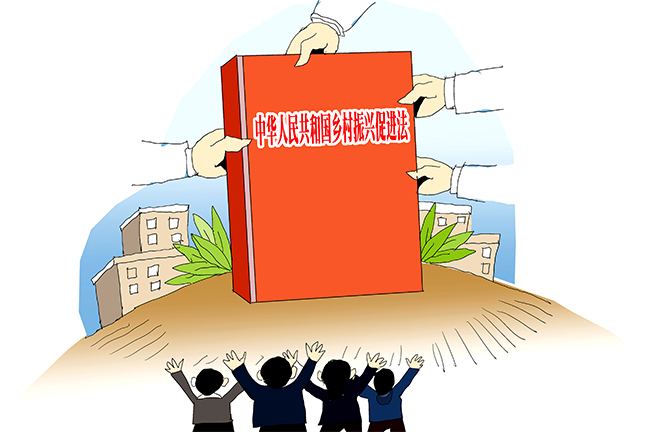Reexamining urban-rural integrated development

A law on the promotion of rural revitalization was adopted by China’s national legislature on April 29th, 2021. Photo: TUCHONG
It was proposed at the Third Plenary Session of the 20th Central Committee of the Communist Party of China that integrated urban and rural development is essential to Chinese modernization. By the end of 2023, China’s urbanization rate had reached 66.16%, indicating a shift from a rural-centered society to an “urban-rural mix.” New industrialization, new urbanization, and all-around rural revitalization are shaping a more harmonious and improved urban-rural relationship, establishing a framework for integrated development between urban and rural areas.
County-level social development
In the early stages, urban and rural areas underwent linear development independently, influenced by geographical, political, economic, and social factors. Urban-rural integration requires breaking this dualistic development model, narrowing urban-rural disparities, and meeting the needs of residents in both settings for a better life. The development of county-level societies serves as the foundation for achieving integrated urban-rural development.
Firstly, the relatively well-established infrastructure and public service systems at the county level constitute the material basis for urban-rural integration. Farmers have more opportunities in the county-level labor market than they do in cities. They are more familiar with the environment, when the costs of housing, settling down, education, and healthcare are lower. Secondly, industrial development at the county level lays a foundation for urban-rural integration. With the advancement of rural revitalization, industries in counties are flourishing. Some mature agricultural industries have been incorporated into urban industrial development, creating industrial connections among cities, counties, and townships, and providing more employment opportunities for farmers.
Building small cities and towns
Promoting the development of small cities and towns offers an additional pathway to achieving urban-rural integration. The academic focus on small towns is inspired by the development concept of “small towns, big strategy” introduced by Chinese sociologist Fei Xiaotong in the 1980s. Fei attempted to construct a bridge between urban and rural areas through the development of small cities and towns.
In practice, urbanization plays an important role in absorbing surplus rural labor and generating significant demand for agricultural products and resources. In the new era, the development of rural areas and farmers should not be restricted to the countryside. Small cities and towns, which blend the characteristics of both urbanization and rural development, can effectively coordinate urban-rural relations. Moreover, successful approaches and key elements in the development of small cities and towns—such as enhancing labor capital, transforming traditional agricultural and industrial structures, and promoting advanced culture, legal awareness, and modern lifestyles—can drive high-quality development in both urban and rural societies.
All-around rural revitalization
Rural areas are central to urban-rural integration, yet they remain a weak link in this process. The underdevelopment of rural areas is a key factor hindering balanced urban-rural development and coordinated regional development in the new era. In light of this, all-around rural revitalization is essential for achieving effective urban-rural integration.
All-around rural revitalization should primarily focus on the development of rural areas themselves. China has accumulated rich experience in rural development, particularly through a series of effective rural governance strategies implemented since the beginning of the 21st century. These include initiatives such as new rural construction, targeted poverty alleviation and reduction, and the Green Rural Revival Program. Achieving all-around rural revitalization requires further exploration of these effective development concepts, working methods, and promotion mechanisms, as well as increased policy support to strengthen agriculture, benefit farmers, and raise rural living standards. However, rural revitalization should not be confined to the development of rural areas only. Its focus should be placed on not only the development within rural areas, but also the urban-rural relationship. This entails coordinating and advancing rural development within the context of China’s ongoing urbanization.
Institutional innovation
Integrated urban-rural development requires equal exchanges and the two-way flow of production factors—such as labor, capital, technology, and land—between cities and the countryside. This in turn requires the creation of a platform for the circulation of these factors through institutional innovation.
Firstly, more effective mechanisms must be created to facilitate urban production factors to flow into the rural area, addressing the urban-rural imbalance in resource allocation. Enterprises and social capital should be guided and encouraged to invest in the rural area through various channels, with more high-quality production factors allocated to key areas and weak points in agricultural and rural development. Moreover, a mechanism is needed to facilitate the upward flow of rural production factors as well as new quality productive forces in rural areas. The basic rural operation system should be further refined, cultivating emerging market factors such as markets for rural land transfer, new agricultural technologies, agricultural product trading, and rural financial capital. It is also necessary to revitalize existing resources and production factors in rural areas, with a particular focus on driving the development of unique resources and production factors such as green ecological assets and local cultural resources.
Han Mengjuan is a lecturer from the School of Law and Public Administration at Hebei Normal University; Lu Yilong is a professor from the Center for Theory and Methodology of Sociology at Renmin University of China.
Edited by WANG YOURAN

 PRINT
PRINT CLOSE
CLOSE